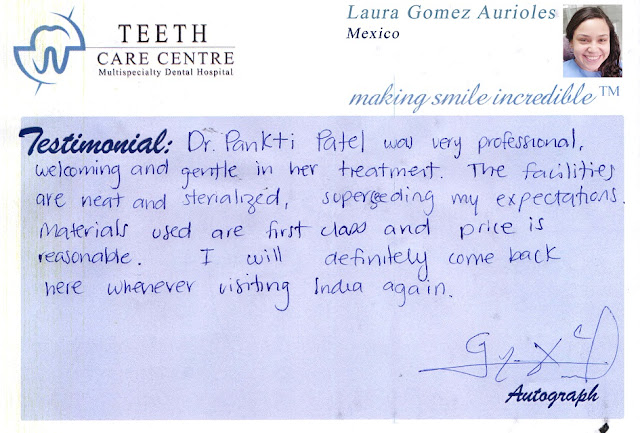making smile incredible™
How to care for your baby's teeth...
Do I need to clean my baby's gums before his
teeth come in?
Yes, Even before your baby sports his first tooth, it's a
good idea to get into the habit of wiping his gums with gauze or a soft wet
washcloth during bath time. You don't need to use any toothpaste yet. Simply
wrap the cloth or gauze around your index finger and rub it gently over his
gums.
What's the best way to brush my baby's teeth
after they start coming in?
As your child's teeth start to appear (generally around 6
months), look for a baby toothbrush with a small head and grip suitable for
your hand. (If your child is healthy and still hasn't gotten her first tooth by
the end of her first year, don't worry – some children don't start getting
teeth until 15 to 18 months.)
Brush twice a day. Brush in the morning and right before
bedtime.
Use a tiny amount of fluoride toothpaste. To avoid giving
your child too much fluoride, use a thin smear of toothpaste or a dot the size
of a grain of rice.
Brush gently on the inside and outside of each of your
baby's teeth, as well as her tongue (if she'll let you), to dislodge bacteria that
can cause bad breath. Since you're using such a small amount of toothpaste,
there's no need to rinse.
When should I start taking my baby to the
dentist?
Take your child to the dentist within six months after
her first tooth erupts, or by her first birthday, whichever comes first.
Do certain foods cause tooth decay in
babies?
Certain foods can contribute to cavities. Sweet foods
like these are a common culprit: Fruit, dried fruit, juice, peanut butter and
jelly.
Starches can also contribute to cavities: Breads, crackers,
pasta, pretzels.
Serve these foods at mealtime rather than as snacks so
they're more likely to get dislodged and won't sit on the teeth too long.
Serving them with water is also helpful.
Don't put your baby to bed with a bottle of milk,
formula, juice, or sweetened liquid. These liquids feed bacteria in the mouth
that cause tooth decay.
For more visit:
Veneers - Pros and Cons
Porcelain
veneers can help individuals with dental flaws such as teeth that are crooked,
discolored, or have small gaps between them. Veneers dramatically change a
person’s smile and, in the process, help improve self-confidence.
Pros of veneers
Realistic appearance: One of the features of porcelain
veneers contributing to their rising popularity is their optic properties.
Porcelain is a ceramic that has many similar properties to the teeth’s natural
covering, enamel. Because of this, porcelain veneers appear natural and
realistic.
Stain-resistance: Porcelain is a ceramic. and is
therefore quite ”glass-like.” Its surface is extremely smooth and impervious.
This makes porcelain veneers quite resistant to permanent stains. No need to
worry about coffee, wine, or cigarette stains!
Durability: Porcelain veneers are relatively long lasting compared to plastic (composite) veneers.
Color versatility: The color of porcelain veneers can be
selected such that it makes dark teeth appear whiter.
Ease of shaping: Compared to crowns, porcelain veneers do
not require extensive shaping prior to the procedure thin.
cons of porcelain veneers
Artificiality: Although they look realistic, porcelain
veneers are artificial teeth, which may be a problem for those desiring a more
natural solution to their dental problem.
High cost: Veneers, especially porcelain veneers, are
expensive.
Fragility: Although porcelain veneers are relatively
tough, they are not impervious to any chipping orbreaking when exposed to
excessive impact or force,
e.g. teeth grinding, eating hard foods, and the
like. Repairing or replacing veneers then becomes an expensive endeavor.
Permanence: When it’s done, there’s no going back.
Teeth sensitivity: Since the veneering procedure requires
the removal of enamel, your tooth may become more sensitive to hot and cold
foods and beverages.
You may not be candidate: If you have unhealthy teeth, weakened teeth, have an inadequate
amount of existing enamel on the tooth surface, or suffer from bruxism.
For more call +91 7878783384
#veneers, #pros, #cons, #TeethCareCentre, #dentist, #india
Types of Dental Braces - Pros and Cons
Stainless Steel Braces - Regular
Pros
Economical
Colored rubbers
available
Cons
Most noticeable
Bigger in size
Long treatment
time
Every month
appointment
Food restriction
Ceramic Braces -
Regular
Pros
Less visible
Cons
Expensive
Greater care
required to maintain “clear” appearance
More chances of
breakage
Staining of
rubbers
Every month
appointment
Food restriction
Stainless Steel
Braces – Self Ligating
Pros
Fast treatment
Small bracket
size
Less appointments
Comfortable
Cons
High treatment
cost compare to regular Braces
Food restriction
Ceramic Braces –
Self Ligating
Pros
Less visible
Fast treatment
Less appointments
Comfortable
Cons
Expensive
More chances of
breakage
Food restriction
Lingual Braces
Pros
Invisible from
exterior observation
Cons
Difficult to
clean
Expensive
Cannot treat
severe cases
Greater
discomfort
Routine
adjustments are difficult and make for lengthy appointments
More visits
required
Aligners
Pros
Visually
invisible
No restrictions
of food and beverage intake
Cons
Not suitable
for all orthodontics cases
Replacements
are costly
Achievement of
results may take longer than with traditional braces
For more visit http://www.teethcarecentre.com or Call +919377783384
Subscribe to:
Comments (Atom)






































